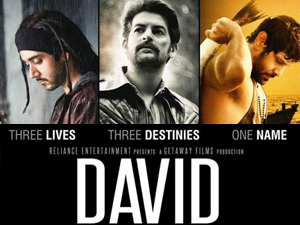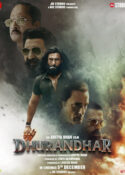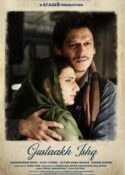 David
David
Starring Vikram, Neil Nitin Mukesh, Vinay Virmani, Tabu, Lara Dutta, Nasser,Rohini Hattangadi, Monica Dogra
Directed by Bejoy Nambiar
Rating: **** ½
Bejoy Nambiar’s second feature film after Shaitaan interconnects the lives of three characters named David, played with outstanding conviction by actors belonging to three different generations. They three protagonists who by chance share the same name didn’t have to be linked in the plot at all. Each David occupies a distinctive emotional spatial and chronological dimension. Each story is told with a muted flourish that eschews the flamboyant edginess of a recent,highly favoured and over-flavoured genre of Hindi cinema…you know the Anurag Kashyap, Vishal Bharadwaj genre where the characters are darkly drawn from life’s most somber colours.
Nambiar’s universe is populated by victims who refuse to bow down to what we call destiny and what in many circumstances is plain cowardice. In the hard-hitting story about a young rock musician’s conflict with religious fundamentalism Vinay Virmani (a prized find) confronts Hindu radical Rohini Hattangadi in a lift to ask why his Christian father was defaced. That small mobile cubicle becomes the cosmos for a question that swirls and dances around the narrative posing questions that go far beyond the moment. Bejoy Nambiar’s command over the space that his characters occupy is supreme. Whether it’s Vinay Virmani giving guitar lessons to single-mother Lara Dutta on a leafy verandah or Southern maverick actor Vikram sozzled in the Goan seascape perched on palm tree making eyes at the mute-and-deaf Isha Shravani….the characters seem to inhabit places where their mind heart and body are intrinsically at home.
Then there is Neil Nitin Mukesh, making a glorious impact as a Muslim don’s chief lieutenant in the London of the 1970s. Shot in a shimmering brooding bewildering play of light and shadow by cinematographer Sanu Verghese, this episode in Nambiar’s trilogy is both a brutal depiction of internecine gangwar and an intense love story , a Shakespearean tragedy set in the 1970s and yet conveying a contemprariness that grips us from the first to the last.
Just how Nambiar manages to bring the stories of an identity-challenged gangster in the 1970s, a fun-going-into-fundamentalism musician in the 80s and a sozzled moony-eyed fisherman in the 1990s into one line of vision, is a question that only Bejoy and his compelling co-writer Natasha Sahgal can answer.
By the time the three stunning stories converge on March 3,2012, we are so involved with the three protagonist’s moral and political awakening that the lines dividing the different eras simply evaporate, leaving us to look into that chasm in the individual’s soul where life’s worthiness is weighed against human relationships that may or may not last for as long as the individual desires.
Nambiar’s three-tiered screenplay is a marvel of architecture. Some credit for holding up the three-storeyed edifice must go to the technicians. Cinematographers Shanu Verghese, P.S Vinod (who has shot Vinay Virmani’s musical odyssey) and R Rathnavelu (creating a Goan idyll for Vikram’s story that goes far beyond touristic titillation) collaborate with the film’s editor , the indomitable Sreekar Prasad to bring to bear an infinite lightness of being on the potentially top-heavy plot.
Bejoy Nambiar’s film could easily have collapsed under the weight of its cleverness . Miraculously the director imparts a ceaseless sense of spontaneity into what appears to be the story of three lives connected only by their first name. Not the most promising of premises to hold up a plot. Yet David is unflinchingly engaging. Nambiar’s command over his characters’ destiny is masterly.And there are so many of them! Big or small the characters leave an enduring mark in the script.
Each of the three actors playing the title role provides an evocative centre to the screenplay. It’s hard to choose a favourite since all three actors occupy entirely distinctive spaces. Neil Nitin Mukesh as a gangster whose loyalty is under murderous pressure works hard to achieve oneness with his character. He looks the part and gives to it a feeling of lived-in familiarity. This is a new beginning for Neil.
Vikram as the fisherman who shares a rather eccentric relationship with his dead dad(Saurabh Shukla) ,living mother(Rubi Chakravarti) and the neighbourhod massage-parlour owner (Tabu) is in one word, spectacular. His body language and spaced-out expressions of drunkenness and love(sometimes both at the same time) are to die for.
But it’s Vinay Virmani as the musician who finds his life changed by politics and religion who takes us by surprise. A very appealing screen presence and a non-rehearsed charm ensure that Virmani stands tall in the formidable cast. This newcomer is here to stay.
Every actor in the smallest of roles shines in the plot’s huge canvas. If I had to single out names in the supporting cast it would be Aakarsh Khurana (as Neil’s ganglord surrogate-father), Neil Bhoopalam (as the ganglord’s punk wastrel of a son), Nasser (as a Christian priest under attack), Rohini Hattangadi (as a Hindu fanatic) and Satish Kaushik (as a silently observant neighbour in Naseer’s chawl). Tabu and Lara Dutta are effective but underused.
Every character and location conveys a remarkable degree of inevitability. The cinema of Bejoy Nambiar is inbued with a paradoxical sense of surrealistic credibility. The characters are dreamers nailed down to a grim ground-reality which they cannot escape. Despite the strident sounds of violence an enchanting lyricism underscores the narrative.There is a sequence on a boat in a river on a moonlit night when Isha Shravani and the love-smitten Vikram break into a jig. You wish it wouldn’t end.You carry that moment with you out of the theatre . There are many such stopovers into splendour and the tender even when the world of the characters is falling apart.
David is world shot in a deep-focus darkness lit up at the edges by a sense of joie de vivre that the characters preserve even when their soul is under siege. Bejoy bleeds brilliancy into the film. This is a rugged pulsating parable of passion and redemption shot in three time zones unified by the theme of love’s loss and the soul redeemed.
David is many things at the same time. Finally though, it is a magnificent morality tale that tells us it is trendy to be bad. But being good is timeless.








